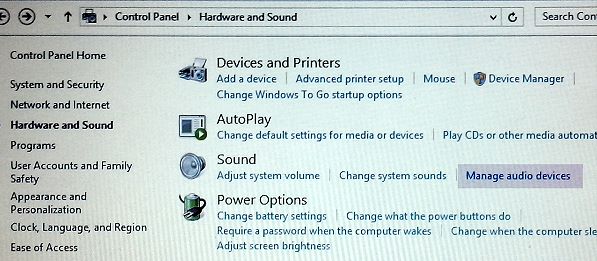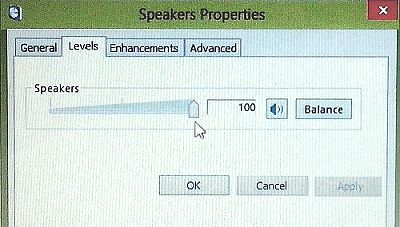|
Modern computer systems are designed to
use as little energy as possible. This well-meaning
principle can often be at the cost of the computer’s
overall performance, making it more likely to experience
audio dropouts.
This means that anything the computer
thinks is not being used will be put to sleep after a
certain period of time, including the USB ports. As luck
would have it, this usually occurs just before the start of
a show, or halfway through a recording!
For audio use, we want everything on and
ready all the time, so the following fixes should be
undertaken to eradicate such energy-saving related
performance problems.
Windows
8 is very new, and has been much
maligned for its completely different user interface, so
finding the appropriate options to change can be tricky. We
tested this thoroughly on a brand new
Windows
8 laptop, with nothing else
loaded.
The laptop was switched on, and then an
ARX USB-DI was plugged into one of the
USB connectors. The laptop found the USB-DI and
installed it as the default audio device in approximately 2
seconds, making it the fastest operating system for finding
USB devices that we have tested!
We intend to keep it that way, so first
of all, let's look at keeping the USB ports in
Windows
8 turned on all the
time
DISABLE the POWER
SAVING OPTION of the USB PORTS
Open the Device Manager
by moving the mouse pointer to the bottom left hand
corner of the screen. You'll see a miniature version of
the desktop screen appear. Right click on it and the menu
below will pop up. Click on Device Manager

You'll see the following
page:

In the Universal Serial Bus
controllers section, right click each USB Root
Hub
Choose Properties then the
Power Management tab on the far Right, and
untick
the box next to Allow the computer to turn off
this device to save power option.
Do this for each USB Root Hub,
Generic USB Hub and any other Hubs listed in
this section. Not all computers will have exactly the
same USB listing; some will have more and some
less.
ADJUST the
AUDIO LEVEL of the USB DI
The Windows default volume
setting for USB Audio Devices is 50% of maximum. For our
purposes this will be too low, inducing noise and hum as
excessive gain may need to be applied to deliver the
level required.
We recommend increasing this volume
setting to 100%
Open the Control Panel by
moving the mouse pointer to the bottom left hand corner
of the screen. You'll see a miniature version of the
desktop screen appear. Right click on it and in the pop
up menu click on Control Panel
Click on the Hardware and Sound
section, and in the Sound section click on Manage
Audio Devices

Click on
ARX USB Device, then the
Properties tab. Click on the Levels tab,
and move the slider all the way to the right
|
Change This
|
To This
|

|

|
Click on OK, then shut down the
previous screens, and you're all done.This will give you
the optimum playback signal to noise ratio.
PLEASE
NOTE:
This still needs to be done even if you are using the
USB DI-VC model. The volume control only affects the
analog outputs, and you'll need to increase the digital
volume first.
On the plus
side, however, from our testing Windows 8 looks like it
will remember this setting each time you connect the same
USB DI to the computer!
GENERAL POWER FIXES
FOR WIN 8
Open the Device Manager by
moving the mouse pointer to the bottom left hand corner
of the screen. You'll see a miniature version of the
desktop screen appear. Right click on it and the menu
below will pop up. Click on Power Options.

The two Power Plan options are
Balanced and High Performance

Set the Power Plan to High
Performance
This will keep the computer and the screen on all the
time. If you are using a laptop running on batteries,
change each option to Never as well, by clicking
on the drop down menu arrows in the On Battery
section above,
Remember,
playback will stop when the batteries go flat! Keep the
charger handy
|







